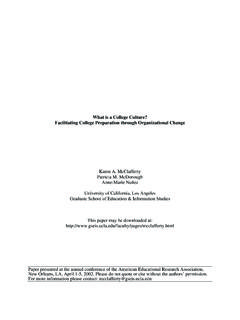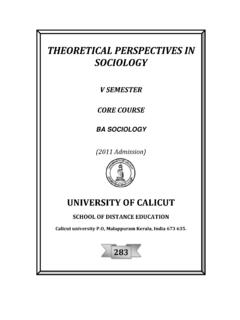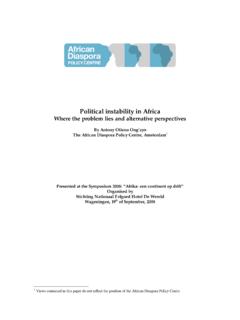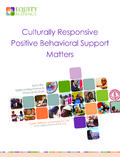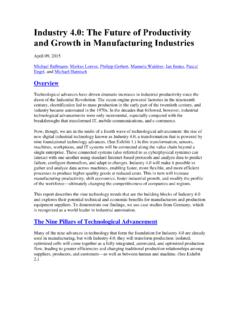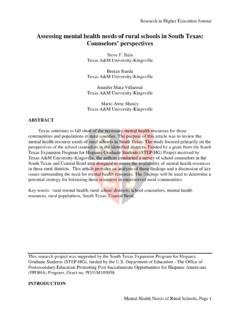Transcription of THEORIES LINKING CULTURE AND PSYCHOLOGY: …
1 Annu Rev. Psychol. 1998, 49:559-84 Copyright 1998 by Annual Reviews Inc. All rights reservedTHEORIES LINKING CULTUREAND psychology : universal andCommunity-Specific ProcessesCatherine R. Cooper and Jill DennerDepartment of psychology , University of California at Santa Cruz, Santa Cruz,California 95064; e-mail: WORDS: CULTURE , theory, identity education, immigration, diversityABSTRACTP sychological THEORIES and research often assume nations are culturally homogeneous and stable. Butglobal demographic, political, and economic changes and massive immigration have sparked newscholarly and policy interest in cultural diversity and change within nations. This chapter reviewsinterdisciplinary advances LINKING CULTURE and psychological development. These challenge andstrengthen the external and ecological validity of psychological THEORIES and their theoretical perspectives are reviewed: individualism-collectivism; ecological systems;cultural-ecological; social identity; ecocultural and.
2 Sociocultural; structure-agency; and multipleworlds. Reviews of each theory summarize key constructs and evidence, recent advances, linksbetween universal and community-specific research and applications, and strengths and chapter traces complementaries across THEORIES for the case of personal and social identity. Itconcludes by discussing implications for science and policy. By viewing THEORIES as distinct yetcomplementary, researchers and policy makers can forge interdisciplinary, international, andintergenerational collaborations on behalf of the culturally diverse communities of which we are and Denner 2 The concept of CULTURE has come to the forefront of social -science and social policy to address issuesof human diversity in psychological processes and performance.
3 Debates about the role of CULTURE inpsychological processes have sparked a movement towards research that is directly applicable tosocial problems. A key challenge lies in how to reconcile community-specific applications withbroader THEORIES that guide is a timely debate for reasons both within and outside the field of psychology . Inanthropology, definitions of CULTURE have long been disputed. Although themes of shared values,beliefs, and behaviors that are transmitted through generations are common, some scholarsemphasize cognitive orientations to ideas, beliefs, and knowledge; others focus on materialistorientations to technological and environmental features; and others concentrate on behavioralorientations or on moral themes. Anthropologists also increasingly probe the disputed aspects ofculture between ethnic groups or nation-states rather than values held in have since ancient times mapped variation within nation-states by asking adults toidentify the country of birth, race, ethnicity, language, income, gender, age, education, andoccupation of each member of their household.
4 These responses, analyzed according to political andgeographical units such as census tracts, cities, states, or provinces, form the basis for policydecisions regarding the allocation of resources; practical decisions about what is done in daily life infamilies, schools, and workplaces; and scientific decisions involving the generality orrepresentativeness of studies based, inevitably, on samples rather than entire populations. Historicalstudies of changing census categories and current debates on a "multiracial" category for the UScensus illustrate the changing and interacting links among political, practical, and scientific bases ofdemographic indicators of variation within multicultural psychologists typically conceptualize diversity within nations in terms of demographicvariables they often treat such variables categorically as quasi-independent variables to assessdifferences between groups.
5 Problems can then arise when scholars view any one variable as asuperordinate package" of other dimensions and interpret that variable as not only descriptive butalso explanatory (Whiting 1976). Interpreting racial or ethnic-group differences as minority-groupdeficits is an inherent risk of such designs, particularly when only two groups are compared (Cooperet al 1998, Garcia Coll et al 1997, McLoyd 1991).Views of cultures as static and/or stable have been disrupted by global demographic, economic, andpolitical changes and growing economic disparities between rich and poor. These massive changeshave sparked fresh debate about cultural change, diversity, and equity among intellectual and politicalleaders who once viewed their nations as stable, homogeneous, and just. Policies such as the US CivilRights Act of 1964 and the Japanese Equal Employment Opportunity Law of 1985 are examples ofchanges that acknowledge diversity by increasing access to educational and occupational waves of immigration, however, now pose a fresh challenge to the democratic ideals oftolerating diversity while enhancing equal access to education.
6 In many nations, immigrantfamilies-both relatively impoverished families and families from relatively impoverished countries(Daniels 1990; Hurrelman 1994) -have arrived in great numbers, seeking better lives for theirchildren. For these families, free public schools are the "hills of gold." Yet despite their dreams, asimmigrant youth move through schools, their numbers shrink, making them expensive socialdilemmas rather than economic and social assets. Educational disparity, once seen as an issue betweenBlack and -white" populations, is now understood as one of cultural pluralism and inclusion, involvingin some communities over 100 different linguistic groups. Their sheer numbers challenge localpractices and government policies stating that schools should provide acculturation for immigrants,liberal education, and preparation for work and citizenship in , worldwide social changes are stimulating psychologists, demographers, sociologists,anthropologists, and other social scientists to rethink issues of cultural diversity both within andCooper and Denner 3across national boundaries.
7 Of course, there is precedent for social scientists to consider as valid whatappear to be incompatible models of the same phenomena. Globalization has led to increasedawareness of differences and similarities both within and across cultures and a search for new modelsof CULTURE . In the physical sciences, compelling empirical evidence supports the validity of viewingelectrons as both particles and waves. Similarly, social scientists in multicultural nations increasinglyview CULTURE as both stable and dynamic, shared by groups and disputed within and across borders, andoperating at multiple levels of , enduring tensions between cultural diversity and national unity fuel ongoing debateamong scientists as well as politicians, families, educators, and youth (Cooper et al 1995, Spindler1990).
8 To address these issues of LINKING CULTURE and psychology , this chapter examines developmentin multicultural nations. For example, identity development involves personal exploration indomains such as ethnicity, occupation, gender role, political ideology, and religious beliefs (Erikson1968, Grotevant & Cooper 1985, 1998); social negotiations in close relationships with families,peers, and others (Archer 1992, Heath & McLaughlin 1993); and collective processes ofcategorization and recategorization of group memberships (Brewer 1991, Root 1992). In addition,societal, institutional, and intergenerational changes point to mechanisms affecting individualdevelopment. Societal changes, such as new laws regulating eligibility for citizenship or universityentrance, can affect how youth develop national or international identities (Denner et al 1997,Goodman 1990).
9 Institutional changes, such as schools' offering new bilingual algebra classes, canfoster occupational development (Chisholm et al 1990, Kroger 1993). Intergenerational as when elders tell old stories while youth learn to ask about them, can foster academic, family,religious, or ethnic identity development (Cooper 1994; Mehan et al 1994, 1996). Presentation ofthese THEORIES in one place may help us find new ways of LINKING universal and community-specificperspectives on CULTURE and Dilemmas in LINKING Cultural- universal and Community SpecificPerspectivesThe resurgence of scholarly and policy debates regarding cultural diversity has also renewed theclassic universalism-relativism debate: how to build scientific generalizations while trying tounderstand diversity, variation, and change in human beliefs and behaviors.
10 Variations across culturalcommunities are rooted in complex histories and interpretations of intergroup relations and varyingaccess to education, employment, and other opportunities. Yet, attending to the unique historieswithin each community challenges fundamental goals of science to build THEORIES that describe andpredict human development as well as explain and enhance life conditions across a range scholars and policy makers seeking to link universal and community specific perspectivesface the classic dilemma of scientific goals conflicting with research application. A traditionalscientific goal is to challenge and strengthen existing theoretical models, both their assumptions ofuniversality and their claims of descriptive, predictive and explanatory adequacy.
